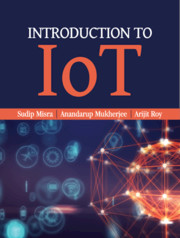6 - IoT Processing Topologies and Types
Published online by Cambridge University Press: 09 January 2021
Summary
Learning Outcomes
After reading this chapter, the reader will be able to:
List common data types in IoT applications
Understand the importance of processing
Explain the various processing topologies in IoT
Understand the importance of processing off-loading toward achieving scalability and cost-effectiveness of IoT solutions
Determine the importance of choosing the right processing topologies and associated considerations while designing IoT applications
Determine the requirements that are associated with IoT-based processing of sensed and communicated data.
Data Format
The Internet is a vast space where huge quantities and varieties of data are generated regularly and flow freely. As of January 2018, there are a reported 4:021 billion Internet users worldwide. The massive volume of data generated by this huge number of users is further enhanced by the multiple devices utilized by most users. In addition to these data-generating sources, non-human data generation sources such as sensor nodes and automated monitoring systems further add to the data load on the Internet. This huge data volume is composed of a variety of data such as e-mails, text documents (Word docs, PDFs, and others), social media posts, videos, audio files, and images, as shown in Figure 6.1. However, these data can be broadly grouped into two types based on how they can be accessed and stored: 1) Structured data and 2) unstructured data.
Structured data
These are typically text data that have a pre-defined structure [1]. Structured data are associated with relational database management systems (RDBMS). These are primarily created by using length-limited data fields such as phone numbers, social security numbers, and other such information. Even if the data is human or machinegenerated, these data are easily searchable by querying algorithms as well as humangenerated queries. Common usage of this type of data is associated with flight or train reservation systems, banking systems, inventory controls, and other similar systems. Established languages such as Structured Query Language (SQL) are used for accessing these data in RDBMS. However, in the context of IoT, structured data holds a minor share of the total generated data over the Internet.
Unstructured data
In simple words, all the data on the Internet, which is not structured, is categorized as unstructured. These data types have no pre-defined structure and can vary according to applications and data-generating sources.
- Type
- Chapter
- Information
- Introduction to IoT , pp. 115 - 127Publisher: Cambridge University PressPrint publication year: 2021

